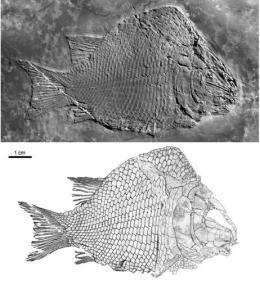First-known ginglymodian fish found from the middle triassic of Eastern Yunnan Province, China

The Ginglymodi are a group of ray-finned fishes that make up one of three major subdivisions of the infraclass Neopterygii. Extant ginglymodians are represented by gars, which inhabit freshwater environments of North and Central America and Cuba. Drs. XU Guanghui and WU Feixiang, Institute of Vertebrate Paleontology and Paleoanthropology (IVPP), Chinese Academy of Sciences, reported the discovery of well-preserved fossils of a new ginglymodian, Kyphosichthys grandei gen. et sp. nov., from the Middle Triassic (Anisian) marine deposits (Guanling Formation) in Luoping, eastern Yunnan Province, China. The discovery documents the first known fossil record of highly deep-bodied ginglymodians, adding new information on the early morphological diversity of this group.
The new ginglymodian species is deep-bodied with a strongly arched hump between head and dorsal fin, and was found in deposits composed by thin lime mudstone interlaid with dark shale, siliceous concretion, and zebra limestone of apparent marine origin. The lithofacies of this fossil site indicate a platform margin or platform margin slope environment. Along with this new fish is a taxonomically rich fossil assemblage, including plants, invertebrates, marine reptiles, and other kinds of fishes.
The studies of functional morphology of extant deep-bodied fishes indicate that Kyphosichthys is not a fast swimmer but has a good performance in precise maneuvering, representing a morphological adaptation to structurally complex habitats (e.g. thick macrophyte beds, rocky areas, or coral reefs), which differs from the other members of this group. “The discovery of the new deep-bodied ginglymodian indicates that the earliest ecological diversification of the Ginglymodi occurred at least in the Middle Triassic”, said XU Guanghui, associate professor of the IVPP and first author of the study, “Its occurrence adds significantly to the ecological diversity of the already known vertebrate fauna from the Middle Triassic marine ecosystem of the eastern Yangtze Sea, which once sustained taxonomically and functionally diverse marine reptiles and other fishes.”
The earliest known neopterygians are found in the Early Triassic. Greater diversification of the Neopterygii occurred in the Middle Triassic, and the Triassic is a period of particular interest to the study of the neopterygian evolution. A cladistic analysis was carried out to assess the phylogenetic relationships of the new fish taxon Kyphosichthys with other taxa of the Neopterygii. The analysis result supports the hypothesis that the Ginglymodi are more closely related to the Halecomorphi than to the Teleostei. These phylogenetic relationships agree with Grande in the resurrection of the term Holostei to include the Ginglymodi and Halecomorphi within the crown-group Neopterygii. Kyphosichthys was identified as a ginglymodian in the Holostei. The analysis also shows that a highly deep and short fish body type has independently evolved at least three times in the stem-group neopterygians, ginglymodians, and basal teleosts within the lower neopterygians of the Triassic, represented respectively by Felberia, Kyphosichthys, and Dapedium.
The original paper was published in the journal of Chinese Science Bulletin (No.1: 111-118) in January 2012.
Journal information: Chinese Science Bulletin
Provided by Institute of Vertebrae Paleontology and Paleoanthropology



















